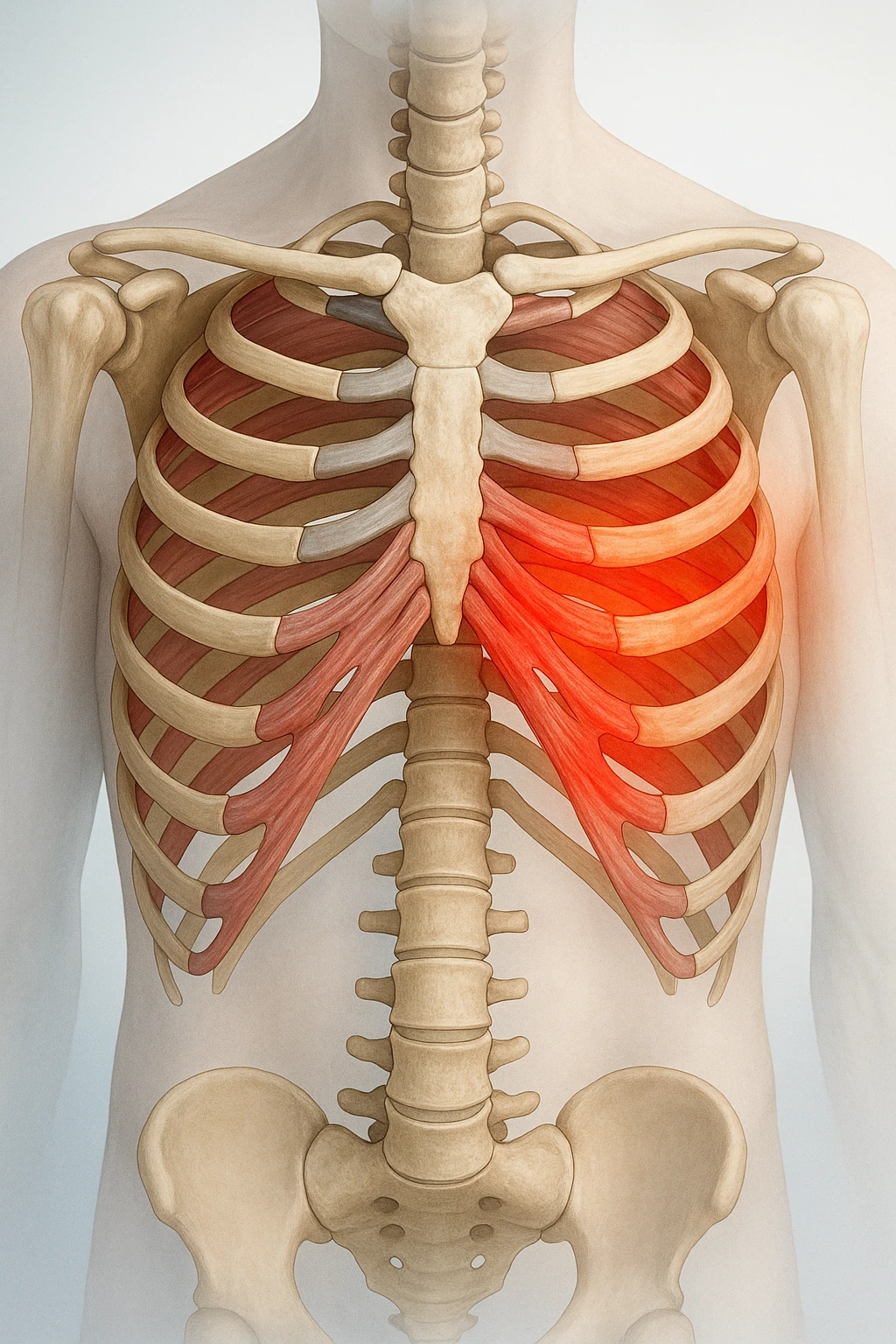Understanding Rib Pain: Causes, Diagnosis, and Effective Management
Understanding Rib Pain
Rib pain is a common clinical complaint that can result from minor inflammation, traumatic rib fractures, or structural instability of the chest wall. It often presents as sharp, localized discomfort that worsens with deep breathing, coughing, or movement. Because the ribs protect vital organs such as the lungs and heart, accurate assessment is essential to rule out internal injury or complications. Most cases arise from musculoskeletal causes such as costochondritis or mechanical disorders like slipping rib syndrome, while fractures may follow blunt trauma or bone weakness. Understanding the cause guides appropriate treatment-from rest and pain relief to advanced interventions for severe injury.
Anatomy and Structure of the Rib Cage
Rib pain refers to discomfort or tenderness along the chest wall, often caused by irritation, inflammation, or injury to the structures that form the rib cage. Because the ribs protect vital organs, pain in this area can interfere with breathing and movement. Understanding the rib cage’s anatomy helps explain why this region is prone to both minor and serious conditions.
Structure of the Rib Cage
- Ribs: Twelve pairs attach to the spine and, for most, to the sternum via cartilage.
- Costal cartilage: Provides flexibility and connects ribs to the sternum.
- Intercostal muscles and nerves: Support breathing and transmit sensory signals that may generate pain when irritated.
Common Anatomical Pain Sites
- Costochondritis: Inflammation at the costochondral junctions of the upper ribs causing localized pain that worsens with deep breathing or pressure.
- Rib fractures: Usually caused by blunt trauma but may occur in weakened bones from osteoporosis or metastases, producing sharp pain during breathing or coughing.
- Slipping Rib Syndrome: Hypermobility of lower ribs irritates nearby intercostal nerves, creating intermittent, sharp pain that may radiate to the upper abdomen.
| Condition | Mechanism | Typical Pain Pattern |
|---|---|---|
| Costochondritis | Inflammation at costochondral junction | Localized, worsens with breathing or pressure |
| Rib fracture | Bone injury from trauma or fragility | Sharp pain, aggravated by movement or coughing |
| Slipping Rib Syndrome | Hypermobility of lower ribs irritating nerves | Intermittent, radiating pain to upper abdomen |
The rib cage’s blend of bones, cartilage, and nerves makes it flexible yet vulnerable. Rib pain can reflect inflammation, injury, or instability-each requiring careful diagnosis and appropriate care.
Major Causes and Clinical Features
Rib pain can arise from several causes, with costochondritis, rib fractures, and slipping rib syndrome being the most common. Each affects distinct areas of the rib cage and presents with characteristic pain patterns and tenderness that aid diagnosis.
Main Causes of Rib Pain
- Costochondritis: Inflammation of the costochondral junctions where the upper ribs meet the cartilage. Causes sharp or aching anterior chest wall pain, worsened by deep breathing or movement, and often reproduced by palpation.
- Rib fractures: Usually follow blunt trauma but may occur with minimal force in individuals with osteoporosis or metastatic disease. Pain is sharp and localized, intensified by movement or coughing, with tenderness at the fracture site.
- Slipping Rib Syndrome: Hypermobility of the lower ribs irritates intercostal nerves, leading to intermittent, stabbing pain radiating around the rib or upper abdomen. The hooking test can reproduce pain and confirm diagnosis.
Shared Clinical Features
| Feature | Description |
|---|---|
| Localization | Pain is well defined and corresponds to the affected rib or cartilage. |
| Aggravating factors | Deep breathing, coughing, and physical movement commonly intensify pain. |
| Physical findings | Pain is often reproducible with palpation or specific maneuvers. |
Recognizing these patterns helps differentiate inflammatory, traumatic, and mechanical sources of rib pain, supporting accurate diagnosis and treatment planning.
Diagnostic Approach to Rib Pain
Diagnosing rib pain begins with thorough clinical assessment. A detailed history and physical examination help identify the cause, focusing on onset, pattern, and triggers of pain. Because rib pain can arise from musculoskeletal, traumatic, or visceral sources, structured evaluation distinguishes benign chest wall pain from serious internal conditions.
1. Clinical Examination
- Inspection and palpation: The clinician checks for tenderness, swelling, or deformity.
- Costochondritis: Diagnosis is primarily clinical, as imaging often appears normal.
- Slipping Rib Syndrome: Confirmed by reproducing pain with the hooking maneuver, which may reveal rib movement.
2. Imaging Studies
| Imaging Modality | Use | Key Findings |
|---|---|---|
| Chest X-ray | First-line for trauma or suspected fracture | Shows displaced or multiple rib fractures |
| CT Scan | Used when X-ray results are inconclusive | Provides detailed bone and lung evaluation |
| Dynamic Ultrasound | Assesses rib motion in Slipping Rib Syndrome | Confirms hypermobility or cartilage displacement |
3. Differential Diagnosis
Clinicians must rule out cardiac and pulmonary conditions that can mimic rib pain. Red flag symptoms such as shortness of breath, radiating chest pain, or systemic signs require further evaluation to exclude heart or lung disease.
A methodical, evidence-based approach combining clinical examination and selective imaging ensures accurate diagnosis and effective management of rib pain.
Management Strategies and Treatment Options
Management of rib pain depends on its cause and severity, following a stepwise approach that starts with conservative care and progresses to advanced interventions if needed. The main goals are to relieve pain, restore breathing mechanics, and prevent complications such as stiffness or limited mobility.
Conservative Management
- Rest and activity modification: Avoid movements that worsen symptoms to allow healing.
- NSAIDs and mild analgesics: Reduce pain and inflammation in mild to moderate cases.
- Local heat or ice therapy: Decreases inflammation and muscle tension, particularly helpful for costochondritis or mild trauma.
Physical Therapy
- Guided exercises: Maintain chest wall flexibility and prevent postural strain.
- Breathing exercises: Encourage lung expansion and prevent stiffness, especially beneficial for older adults and those recovering from rib fractures.
Advanced Interventions
| Intervention | Purpose | Indications |
|---|---|---|
| Nerve blocks / Epidural analgesia | Provide pain relief to improve breathing and mobility | Used for severe or persistent pain unresponsive to conservative therapy |
| Surgical stabilization | Restores chest wall alignment and function | Recommended for complex or unstable rib fractures |
Multimodal Analgesia
This combined approach integrates pharmacologic, physical, and interventional therapies to optimize pain control and reduce opioid dependence. It promotes deeper breathing, early mobilization, and faster recovery.
By combining these strategies, clinicians can individualize rib pain treatment to achieve effective and safe healing.
Complications, Prognosis, and Prevention
Most cases of rib pain resolve with appropriate treatment, but complications may develop if pain is ignored or if injuries are severe. Since the ribs protect vital organs and aid breathing, persistent pain or poor healing can affect overall health and mobility.
Potential Complications
- Pneumothorax: Air leakage into the space around the lungs due to untreated rib fractures.
- Organ injury: Displaced bone fragments may damage nearby tissues.
- Pneumonia: Shallow breathing from pain can prevent full lung expansion, raising infection risk.
- Chronic pain: Nerve irritation or incomplete healing may cause lasting discomfort and reduced activity tolerance.
Prognosis
| Condition | Typical Recovery Time | Notes |
|---|---|---|
| Costochondritis | Several weeks to a few months | May persist longer in some individuals |
| Simple rib fractures | 6-8 weeks | Heals with adequate pain control and breathing exercises |
| Slipping Rib Syndrome | Variable | Severe or recurrent cases may require surgical stabilization |
Prevention and Self-Care
- Perform deep-breathing and gentle movement to maintain lung function during recovery.
- Avoid chest wall strain and high-impact activity until healing is complete.
- Use protective gear during contact sports or high-risk activities.
- Seek timely medical evaluation for persistent or worsening rib pain.
Key takeaway: Most rib pain improves with conservative care and time. Maintaining proper breathing, managing pain, and seeking early medical advice can prevent complications and promote full recovery.
Frequently Asked Questions About Rib Pain
What are the most common reasons someone develops rib pain?
Rib pain can result from muscle strain, inflammation of the rib joints, trauma such as a fall, or structural issues like slipping rib syndrome. In some cases, underlying conditions like osteoporosis make the ribs more prone to injury.
How can I tell if my rib pain is serious?
Seek medical evaluation if rib pain is severe, persistent, or associated with shortness of breath, chest pressure, dizziness, or fever. These symptoms may indicate complications involving the lungs, heart, or internal organs.
Can rib pain be treated at home?
Mild rib pain often improves with rest, over-the-counter pain relievers, and gentle breathing exercises. However, if the pain worsens or limits your ability to breathe deeply, professional care is recommended.
How long does it take for rib pain to heal?
Recovery depends on the cause. Minor inflammation may improve in a few weeks, while simple rib fractures typically heal within six to eight weeks with proper pain control and breathing support.
Is it safe to exercise when experiencing rib pain?
Light movement and stretching can help prevent stiffness once acute pain subsides. Avoid high-impact or twisting activities until cleared by a healthcare provider to prevent reinjury.
What complications can occur if rib pain is left untreated?
Untreated rib pain, especially from fractures, can lead to lung problems such as pneumonia or pneumothorax. Chronic pain may also develop if nerve irritation or incomplete healing persists.
When should I see a doctor about rib pain?
Consult a doctor if pain lasts longer than a few days, interferes with breathing, follows trauma, or is accompanied by coughing up blood or other concerning symptoms. Early assessment helps prevent serious complications.













